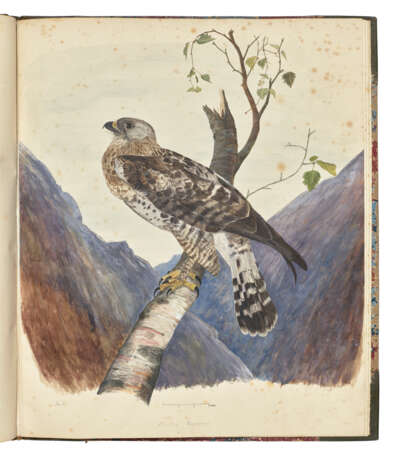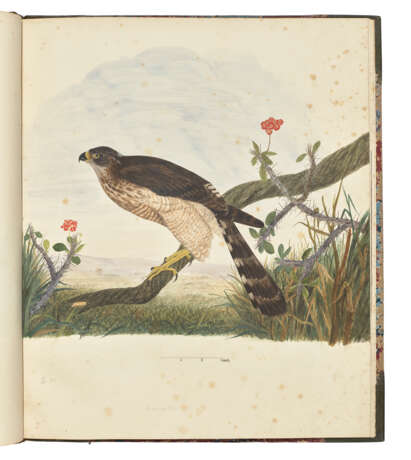NEWTON, Alfred (1829-1907)
10.12.2025 12:00UTC +00:00
Classic
Pour enchérir, allez sur le site
CHRISTIE'S| Auctioneer | CHRISTIE'S |
|---|---|
| Lieu de l'événement | Royaume-Uni, London |
| Commission | see on Website% |
ID 1514349
Lot 97 | NEWTON, Alfred (1829-1907)
Valeur estimée
8000GBP £ 8 000 – 12 000
Raptores drawn and coloured by Professor Alfred Newton [thus titled on upper cover]. [1854-1859].
Fascinating collection of drawings of birds of prey by Alfred Newton, the first Professor of Zoology and Comparative Anatomy at Cambridge University, and the initiator of acts of Parliament for the preservation of birds. This set of drawings was executed by Newton when he was relatively young. He graduated from Magdalene College, Cambridge, with his BA in English in 1853, and then won election to the Drury travelling fellowship, allowing him ten years of ornithological study in places such as northern Scandinavia (1855) and Iceland (1858). He was often accompanied by his friend and fellow ornithologist, John Wolley (1823-1859). When Wolley died in 1859, he bequeathed his egg collection and notebooks to Newton who catalogued them in Ootheca wolleyana (1864-1907) before donating the collection to the British Museum. One of the smaller (non-raptor) drawings bound into this collection of Tringa temminckii (now Calidris temminckii, or Temminck's Stint) has the inscription on verso (probably in John Henry Gurney Jr’s hand) that states: ‘This picture was done by A. Newton from the parent of the first nest Wolley ever got, and the eggs the first that ever came to England – in 1853.’
Newton’s drawings would have found a natural home with John Henry Gurney Jr, as the latter was very much interested in birds of prey. Gurney was also heavily involved with the natural history collections at the Norwich Museum (Wolley himself had donated a collection of about 120 Indian bird skins there) and Gurney published a comprehensive Catalogue of the Birds of Prey (Accipitres and Striges) with the number of Specimens in Norwich Museum in 1894.
Despite Gurney requesting further skins of birds of prey in his catalogue (p.53), and Newton acquiring Wolley’s egg collection, Newton himself took particular interest in extinct species such as the dodo and the great auk, and the great bustard which had only recently disappeared from Britain. Therefore, it was natural that Newton championed protective legislation of birds; his paper to the British Association at Norwich in 1868 led directly to the first of many protective acts, the 1869 Sea Birds Preservation Act, and later was a supporter of the fledgeling Society for the Protection of Birds in 1889.
Large folio (525 x 435mm). 9 Large-format drawings of birds of prey by Newton, all but one with scale at foot, 4 dated 1854 with initialled monogram ‘AN’, one dated 1856-1859, 7 numbered in pencil but bound out of sequence, all but one captioned in pencil with occasional notes on scale, bound with three much smaller drawings of other birds by Newton, 2 of which dated 1854 with initialled monogram ‘AN’, and with manuscript notes by Newton and Gurney on versos (some captions trimmed by the binder, variable spotting throughout). Contemporary olive-green half morocco over marbled-paper covered boards, olive-green morocco gilt lettering piece to upper cover (extremities rubbed). Provenance: John Henry Gurney Jr (1848-1922, ornithologist; bookplate and piece of paper loosely inserted with Gurney’s autograph signature).
| Lieu d'origine: | Europe du Nord, Europe, Royaume-Uni |
|---|---|
| Catégorie maison de vente aux enchères: | Lettres, documents et manuscrits, Livres et manuscrits |
| Lieu d'origine: | Europe du Nord, Europe, Royaume-Uni |
|---|---|
| Catégorie maison de vente aux enchères: | Lettres, documents et manuscrits, Livres et manuscrits |
| Adresse de l'enchère |
CHRISTIE'S 8 King Street, St. James's SW1Y 6QT London Royaume-Uni | |
|---|---|---|
| Aperçu |
| |
| Téléphone | +44 (0)20 7839 9060 | |
| Commission | see on Website | |
| Conditions d'utilisation | Conditions d'utilisation |




